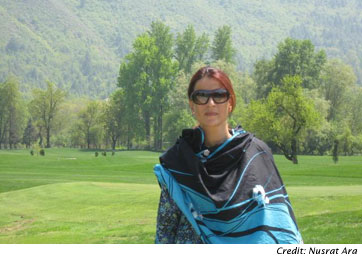
 SRINAGAR, Indian-administered Kashmir (WOMENSENEWS)–Her father is a retired agrostologist, which means he studied grasses. And in her childhood she loved playing with boys.
SRINAGAR, Indian-administered Kashmir (WOMENSENEWS)–Her father is a retired agrostologist, which means he studied grasses. And in her childhood she loved playing with boys.
Maybe that helps explain Nuzhat Gul’s confidence as the first female turf manager of the Royal Springs Golf Course in Srinagar, the summer capital of Indian-administered Kashmir.
At 35, Gul is the first woman to look after the 18-hole golf course.
She holds this historic post for historic reasons. In 1999, as India and Pakistan started fighting on the hills of Kargil, some 200 kilometers from Srinagar, Western countries issued advisories to its citizens. The U.S. turf manager of Royal Springs duly left.
No other qualified turf professionals were available when the job came her way in 2002. She wound up taking what she describes as a job involving lots of physical labor.
"It is definitely not a white-collar job but a challenging 24-hour job,’" said Gul.
Some years back when she attended a course in turf management at the University of Massachusetts in Amherst, she was the only woman in a class of 64. She stood apart for other reasons as well. "I was the only woman, from a rural background and a developing country," recalled the soft-spoken Gul.
For Gul it was a long way from her village in southern Kashmir, where women who venture beyond homemaking are in more typically female professions such as teaching.
Golf Introduced During British Rule
Golf was introduced to India during British rule and was only played by social elites after independence.
"But now it has come out of the cantonments," Gul said, referring to military officers’ garrisons. "It is a common man’s game now. Golf in India is taking up in a big way to the extent that builders are adding golf courses to increase the value of their properties."
The number of golf courses in India–currently 220–is growing fast, with 37 under construction and 65 more being planned, according to Anil Dev, the editor of Golf Plus magazine.
Gul says that the rapid expansion of golf courses is creating a demand for qualified turf professionals, which she hopes will open the field to more women.
The average base salary globally for golf course superintendents in 2005 was $68,914 and goes as high as $125,000, according to Rutgers Professional Golf Turf Management School in New Jersey.
Turf professionals, Gul adds, are not limited to golf but also care for the grounds of other sports such as cricket. "There is no sight like a perfectly-manicured lawn" said Gul.
A self-described "home bird," Gul says she recently declined an offer from a Dubai-based golf course because she wanted to stay close to her family.
Gul started her career as an intern in landscape management with real estate giant DLF in Chandigarh when some friends told her about an opening at the Srinagar Golf Course. She had just completed a bachelor’s degree in landscaping and floriculture from Punjab University.
Returning Home
"I had no intention of coming back to Srinagar but my mother had taken ill so I wanted to be home," said Gul, whose family owns apple orchards. "I had knowledge about the basic fundamentals involved like plant physiology, soil chemistry and the rest I learned on the job."
Going to Punjab University also got her away from the fighting that surrounded her town as she was growing up. Armed insurgency against Indian rule was at its peak in the 1990s and gunfights and bombings were daily occurrences.
As a turf manager, Gul has faced other sorts of menace.
One recently took the form of white grubs, an insect that drew bears from the nearby forest. That created the problem of a torn-up golf course with bears roaming around.
With a smile, Gul remembers newspaper stories about a woman spoiling the expensive golf course. She says she was under heavy pressure from the management to solve the problem.
Most of the chemicals for eliminating white grubs are not allowed in India so Gul had to find a solution herself.
She enlisted the help of a local agricultural university, where two research students worked with her for many weeks on possible solutions. In addition to using chemicals on the bugs, they came up with a special fence that wards off bears and other wild animals by sending electromagnetic waves. Gul happily describes how their point-by-point remedy is regarded "as a reference on the problem of white grubs today."
Nusrat Ara is a freelance journalist based in Indian-administered Kashmir. She contributes frequently for the Press Institute, WIP and WINGS.


